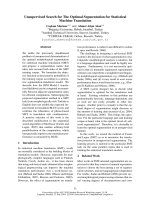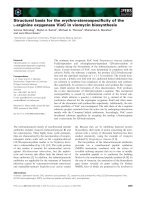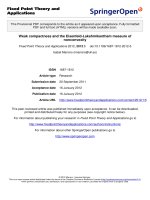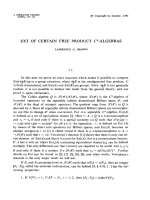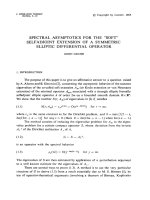Báo cáo toán học: "Threshold Functions for the Bipartite Tur´n Property a" potx
Bạn đang xem bản rút gọn của tài liệu. Xem và tải ngay bản đầy đủ của tài liệu tại đây (268.49 KB, 14 trang )
Threshold Functions for the Bipartite Tur´an Property
Anant P. Godbole
Department of Mathematical Sciences, Michigan Technological University, Houghton, MI 49931-1295,
U.S.A. ()
Ben Lamorte
Engineering and Economic Systems Department, Stanford University, Stanford, CA 93405-4025, U.S.A.
()
Erik Jonathan Sandquist
Department of Mathematics, Cornell University, Ithaca, NY 14853-7901, U.S.A. ()
Submitted: May 20, 1997; Accepted: August 20, 1997
MR Subject Numbers: 05C50, 05C80, 05C35, 05B30
ABSTRACT
Let G
2
(n) denote a bipartite graph with n vertices in each color class, and let z(n, t)
be the bipartite Tur´an number, representing the maximum possible number of edges in
G
2
(n) if it does not contain a copy of the complete bipartite subgraph K(t, t). It is then
clear that ζ(n, t)=n
2
−z(n, t) denotes the minimum number of zeros in an n ×n zero-one
matrix that does not contain a t × t submatrix consisting of all ones. We are interested
in the behaviour of z(n, t) when both t and n go to infinity. The case 2 ≤ t n
1/5
has been treated in [9] ; here we use a different method to consider the overlapping case
log n t n
1/3
. Fill an n ×n matrix randomly with z ones and ζ = n
2
−z zeros. Then,
we prove that the asymptotic probability that there are no t ×t submatrices with all ones
is zero or one, according as z ≥ (t/ne)
2/t
exp{a
n
/t
2
} or z ≤ (t/ne)
2/t
exp{(log t −b
n
)/t
2
},
where a
n
tends to infinity at a specified rate, and b
n
→∞is arbitrary. The proof employs
the extended Janson exponential inequalities [1].
1
the electronic journal of combinatorics 4 (1997), #R18 2
1. INTRODUCTION AND STATEMENT OF RESULTS
Given a graph F , what is the maximum number of edges in a graph on n vertices
that does not contain F as a subgraph? In the bipartite case, we let z(n, t) denote the
(diagonal) bipartite Tur´an number, which represents the maximum number of edges in
a bipartite graph [with n vertices in each color class] that does not contain a complete
bipartite graph K(t, t) of order t. An equivalent formulation of this problem is in terms
of zero-one matrices, and is called the problem of Zarankiewicz: What is the smallest
number of zeros ζ(n, t) that can be strategically placed among the entries of an n × n
zero-one matrix so as to prevent the existence of a t ×t submatrix of all ones? We remind
the reader that, in this formulation, the submatrix in question need not have consecutive
rows or columns. It is clear that ζ(n, t)=n
2
−z(n, t). [Generalizing this problem to s ×t
submatrices of a zero-one matrix of order m×n leads naturally to the numbers z(m, n, s, t)
and ζ(m, n, s, t); Bollob´as [4]has shown that
2ex(n, K(s, t)) ≤ z(n, n, s, t),
where ex(n, F ) denotes the maximum number of edges in a graph on n vertices that does
not contain F as a subgraph.] In contrast with the classical Tur´an numbers, definitive
general results are not known in the bipartite case. The initial search for numerical values
of z(n, t),t=3,4,5 ;n=4,5,6, ,due to Zarankiewicz; Sierpinski; Brzezinski;
ˇ
Culik;
Guy; and Zn´am, is chronicled in [4], as is the history of research (due to Hartman, Myciel-
ski and Ryll-Nardzewski; and Rieman) leading to asymptotic bounds on z(n, 2), and on
z(m, n, s, t) (the latter set of results are due to K¨ov´ari, S´os and Tur´an; Hylt´en-Cavallius;
and Zn´am). The asymptotics of the numbers z(n, n, 2,t)(tfixed) and z(n, 3) have most
recently been investigated by F¨uredi ([6], [7]) who also describes the early related work
of Rieman; K¨ov´ari, S´os and Tur´an; Erd˝os, R´enyi and S´os; Brown; Hylt´en-Cavallius; and
M¨ors. An excellent survey of these and related questions can be found in Section VI.2
of [4]. A problem similar in spirit to the Zarankiewicz question is the object of intense
study in reliability theory; see [2] for details and references, and [3] for background on the
Stein-Chen method of Poisson approximation.
2
the electronic journal of combinatorics 4 (1997), #R18 3
Most of the work described in the previous two paragraphs has focused on the case
where the dimensions (s, t) of the forbidden submatrix are fixed, and n tends to infinity;
a notable exception to this is provided by the recent work of Griggs and Ouyang [11],
and Gentry [8], who each study the half-half case, and derive several bounds and exact
values for the numbers z(2m, 2n, m, n). We continue this trend in this paper, focus on
the diagonal case m = n; s = t, and study the asymptotics of the problem as both n and
t tend to infinity. Our arguments will force us to assume that log n t n
1/3
, where,
given two non-negative sequences a
n
and b
n
, we write a
n
b
n
if a
n
/b
n
→ 0(n→∞).
We thus obtain an extension of the results in [9], where the overlapping case 2 ≤ t n
1/5
was considered. Similarities and differences between the approaches in [9] and the present
paper will be given later in this section, and in the next section. Since z(n, t) ∼ n
2
for
the range of t’s that we consider, we will occasionally rephrase our results in terms of the
minimum number ζ(n, t) of zeros of an n × n 0-1 matrix that prevents the existence of
a t × t submatrix of all ones. The key general bounds due to Zn´am [15] and Bollob´as [
4](Theorems VI.2.5 and VI.2.10 in [4], adapted to our purpose,) are as follows:
n
2
− (t −1)
1/t
n
2−
1
t
−
n(t −1)
2
≤ ζ(n, t) ≤
2n
2
log n
t
{1+o(1)} (t →∞; tlog n),
(1)
In particular, with t = n
α
,α<1/2, we have
(1 −α)n
2−α
log n{1+o
∗
(1)}≤ζ(n, n
α
) ≤ 2n
2−α
log n{1+o(1)}. (2)
We restate (1) and (2) in probabilistic terms as follows: Consider the probability measure
P
u,z
that randomly and uniformly places ζ zeros and z = n
2
− ζ ones among the entries
of the n × n matrix [the subscript u refers to the fact that the allotment is uniform, and
the subscript z to the fact that there are z ones in the array.] Let X denote the random
variable that equals the number of t ×t submatrices consisting of all ones [we often denote
such a t × t matrix by J
t
]. In other words,
X =
(
n
t
)
2
j=1
I
j
3
the electronic journal of combinatorics 4 (1997), #R18 4
where I
j
= 1 if the j
th
t × t submatrix equals J
t
[I
j
= 0 otherwise]. Equation (1) may
then be rephrased as
ζ ≤ n
2
− (t −1)
1/t
n
2−
1
t
−
n(t −1)
2
⇒ P
u,z
(X =0)=0 (3)
and
ζ ≥
2n
2
log n
t
{1+o(1)}⇒P
u,z
(X =0)>0. (4)
The rate of growth of the numbers ζ(n, t) is given by (3) and (4); if t = n
α
, for example,
this rate is of order n
2−α
log n. We will primarily be concerned with proving results
that maintain the flavor of Bollob´as’ and Zn´am’s results, through the establishment of a
threshold phenomenon for P
u,z
(X = 0), i.e., a threshold function for the bipartite Tur´an
property.
One may obtain a clue as to the direction in which results such as (3) and (4) may
be steered by using the following rather elementary probabilistic argument: Suppose that
P denotes the probability measure that independently allots, to each position in [n] ×[n],
a one with probability p and a zero with probability q =1−p, where p and q are to
be determined. Then, with X representing the same r.v. as before, E(X)=
n
t
2
p
t
2
≤
K(ne/t)
2t
p
t
2
/t → 0ifp=(t/ne)
2/t
exp{(log t − b
n
)/t
2
}, where b
n
→∞is arbitrary, so
that by Markov’s inequality, P(X =0)→1iftheexpected number of ones is less than
n
2
(t/ne)
2/t
exp{(log t − b
n
)/t
2
}. The question, of course, is whether this is true if the
actual number of ones is at the same level, i.e., under the measure P
u,z
.
In this paper, we use the extended Janson exponential inequalities [1] to show that
both P(X = 0) and P
u,z
(X = 0) enjoy a sharp threshold at the level suggested by the
above reasoning. Specifically, we prove
Theorem. Consider the probability measure P that independently allots, to each position
in X =[n]×[n]={1,2, ,n}×{1,2, ,n}, a one with probability p and a zero with
probability q =1−p.Lettsatisfy log n t = o(n
1/3
), and set X =
(
n
t
)
2
j=1
I
j
, with I
j
=1
iff J = J
t
, where J represents the j
th
t ×t submatrix of X, and I
j
=0otherwise. Then
p =
t
ne
2/t
exp
log t + a
n
t
2
⇒ P(X =0)→0(n→∞)
4
the electronic journal of combinatorics 4 (1997), #R18 5
and
p =
t
ne
2/t
exp
log t −b
n
t
2
⇒ P(X =0)→1(n→∞)
where b
n
→∞is arbitrary, and a
n
≥ 2t + log(n
2
/t
2
)+δ
n
, where δ
n
→∞is arbitrary.
As a consequence of the above theorem, we will show that it is possible to prove a
result with a fixed (as opposed to random) number of ones, i.e., to prove that P
u,z
(X =0)
tends to zero or one according as z, the number of ones in the matrix, is larger than
n
2
(t/ne)
2/t
exp{(log t + a
n
)/t
2
}, or smaller than n
2
(t/ne)
2/t
exp{(log t − b
n
)/t
2
}. This
comes as no surprise, since it is well-known that many graph theoretical properties hold
under the model G(n, p) if and only if they hold under the model G(n, m), with m = np.
In particular, with t = n
α
, we see that J
t
submatrices pass from being sparse objects
to abundant ones at the level ζ = 2(1 − α)n
2−α
log n. As a further corollary, we will be
able to improve the general upper bound ζ(n, t) ≤ (2n
2
log n)/t{1+o(1)} to ζ(n, t) ≤
2n
2
(log(n/t))/t{1+o(1)}, with the most significant improvement being when t = n
α
.
The versatility of Janson’s inequalities in combinatorial situations has been well-
documented; see, for example, the wide range of examples in Chapter 8 of [1] , or the
work of Janson, Luczak, and Ruci´nski [12], who establish the definitive threshold results
for Tur´an-type properties in the unipartite case. Recent applications of these exponential
inequalities include an an analysis of the threshold behaviour of random covering designs
([10] ); of random Sidon sequences ( [14]); and of the Schur property of random subsets (
[13]). A recent analysis of graph-theoretic properties with sharp thresholds may be found
in [5].
We end this section by stating the connections between this paper and [9]. In [9],
the same problem was treated as in this paper, and the (regular) Janson exponential
inequalities yielded the threshold function for the Zarankiewicz property for 2 ≤ t n
1/5
.
A comment was made that the same technique would probably work, with a large amount
of extra effort, for t’s up to o(n
1/3
). In this paper, we choose, instead, to use the extended
Janson inequalities, together with a different technique for bounding the covariance terms,
to prove this fact. We indicate methods by which the main result could, possibly, be
extended to t = o(n
1/2
). Other points of difference and similarity with [9] will be indicated
at various points throughout this paper.
5
the electronic journal of combinatorics 4 (1997), #R18 6
2. PROOFS
Proof of the Theorem:
We have already provided a proof of the second part of the theorem using nothing
more than Markov’s inequality, and now turn to the first half. Throughout, we assume
that p =(t/ne)
2/t
exp{(log t + a
n
)/t
2
}, with conditions on a
n
to be determined. Let B
j
be the event that the j
th
t × t submatrix, denoted by J, equals J
t
, i.e., has all ones. We
recall the Janson and extended Janson inequalities ( [1]):
P(X =0)≤exp
−µ +
∆
2(1 −ε)
; (5)
and
P(X =0)≤exp
−
µ
2
(1 −ε)
2∆
, (6)
where
ε =p
t
2
;
µ =
n
t
2
p
t
2
= E(X); and
∆=µ
t
r,c=1
r+c<2t
t
r
n −t
t −r
t
c
n −t
t −c
p
t
2
−rc
; (7)
and (in (6)) provided that ∆ ≥ µ(1−ε). We also mention the bound based on Chebychev’s
inequality, known in the combinatorics literature ( [1]) as the second-moment bound:
P(X =0)≤
∆+µ
µ
2
. (8)
In [9], (5) was used to obtain the required threshold for 2 ≤ t n
1/5
with ∆ as in (7),
and it was noted that the second moment bound (8) could also be employed–but with a
worse rate of approximation, and without any significant reduction in the calculation. It
can readily be checked, moreover, that if the exact form of (7) is used for ∆, then ∆ = o(1)
iff µ
2
/∆ →∞iff t = o(n
1/5
), so that even the extended Janson inequality will not lead to
an improvement in the results of [9]. We need, therefore, to work with a different method
in conjunction with (6), and proceed as follows: Since k! ≥ A
√
k(k/e)
k
,k =1,2, , and
6
the electronic journal of combinatorics 4 (1997), #R18 7
k! ≥ (k/e)
k
,k =0,1,2, , where A = e/
√
2 and we interpret 0
0
as unity, (7) yields the
estimate
∆ ≤ ∆
1
+∆
2
(9)
where
∆
1
≤
4
e
4
n
t
2
p
2t
2
t−1
r,c=1
te
c
c
te
r
r
ne
t −r
t−r
ne
t −c
t−c
1
rc(t −r)(t − c)
p
−rc
≤
n
t
2
p
2t
2
t−1
r,c=1
te
c
c
te
r
r
ne
t −r
t−r
ne
t −c
t−c
1
t −1
p
−rc
=
n
t
2
p
2t
2
t−1
r,c=1
ϕ(r, c)say, (10)
and
∆
2
≤
n
t
2
p
2t
2
max{r,c}=t
r+c<2t
ψ(r, c), (11)
where
ψ(r, c)=(t−1)ϕ(r, c)=
te
c
c
te
r
r
ne
t−r
t−r
ne
t−c
t−c
p
−rc
(max{r, c} <t);
e
t
te
r
r
ne
t−r
t−r
p
−rt
(c = t, r < t);
e
t
te
c
c
ne
t−c
t−c
p
−ct
(r = t,c<t)
e
2t
p
−t
2
(r=c=t).
Note that ϕ and ψ are each defined on the compact subset 1,t]
2
of R
2
. Now, in the main
result of [9], both a
n
and b
n
could be taken to be arbitrary. We cannot prove such a result,
in our current theorem, for t’s of the form Ω(n
1/5
) ≤ t = o(n
1/3
) due, basically, to the
above-described “inflation” in the value of ∆. Actually, as we shall see, this is not really
an inflation at all: when p equals a slightly higher value, the proof of the theorem will
reveal that the maximum summand in ∆ (given by (9) through (11)) corresponds to (1,1),
whereas the maximum summand in [9]was at (t − 1,t), but for a smaller value of p, and
with ∆ given by (7). The overall effect, however, is for ∆ to decrease. The proof of the
theorem proceeds by a sequence of lemmas:
Lemma 1. The function ψ(r, c), extended to the closed domain A =[1,t]
2
\(t−1,t]
2
of
R
2
, has critical points only along the diagonal {(r, c):r=c}
7
the electronic journal of combinatorics 4 (1997), #R18 8
Proof. Writing ψ on the interior of A as
ψ(r, c) = exp
log A
c
+ r log
te
r
+(t−r) log
ne
t −r
+ rc log s
where A
c
depends only on c, and s =1/p, we see that
∂ψ
∂r
= e
log ψ
log
te
r
− log
ne
t −r
+ c log s
which equals zero if
(t −r)s
c
r
=
n
t
.
Similarly we verify that ∂ψ/∂c = 0 if (t −c)s
r
/c = n/t. It follows, that at a critical point,
(t −r)
rs
r
=
(t −c)
cs
c
.
Now, since the function η(x)=(t−x)/xs
x
;(1≤x≤t), is decreasing, it follows that
η(r)=η(c)⇒r=c. The lemma follows.
Lemma 2. ψ(1, 1) ≥ ψ(1,x)=ψ(x, 1) ∀x ∈ [1,t], provided that t
2
= o(n) and t log n.
Proof. We show that ψ(1,x) is decreasing in x. Since ψ(1,x)=K(te/x)
x
(ne/(t −
x))
t−x
p
−x
for a constant K, we see that the sign of dψ(1,x)/dx is determined by the
quantity log(te/x)−log(ne/(t−x))+log s = log(t(t−x)s/nx), which is negative if t
2
s ≤ n.
This concludes the proof of Lemma 2, since p ≈ 1 in all the cases we consider.
Lemma 3. ψ(1, 1) ≥ ϕ(1, 1) ≥ ψ(t, x)=ψ(x, t) ∀x ∈ [1,t −1], provided that t
2
=
o(n),t log n, and p =(t/ne)
2/t
exp{(log t + a
n
)/t
2
} with a
n
restricted to a range to be
specified below.
Proof. We consider the function ψ(t, x)=e
t
(te/x)
x
(ne/(t − x))
t−x
p
−tx
, the sign of
whose derivative is determined by the quantity log(t(t − x)s
t
/nx); it is easy to verify
that ψ
(t, x) ≥ 0 provided that x ≤ t
2
s
t
/(n + ts
t
). We next find conditions under which
t
2
s
t
/(n + ts
t
) ≥ t −1; this inequality may be checked to hold provided that s
t
≥ n, i.e., if
np
t
≤ 1. Now if we set p =(t/ne)
2/t
exp{(log t + a
n
)/t
2
} we see that we must have
exp{(log t + a
n
)/t}≤ne
2
/t
2
(12)
8
the electronic journal of combinatorics 4 (1997), #R18 9
in order for t
2
s
t
/(n + ts
t
) to exceed t −1. Since t
2
= o(n), we can always choose a
n
→∞
slowly enough so that (12) holds. But we must be more careful, for reasons that will soon
become apparent, and note, more specifically, that
a
n
≤ t log
ne
2
t
2
− log t (13)
will certainly suffice. Lemma 3 will follow if we can show that ϕ(1, 1) ≥ ψ(t, t − 1),
i.e., that (n/t)
2t−3
≥ 4p
−t
2
+t
, and thus, with p =(t/ne)
2/t
exp{(log t + a
n
)/t
2
}, that
exp{a
n
− 2t}≥Kn/t
2
. The last condition clearly holds if
a
n
≥ 2t + log
n
t
2
+ δ
n
, (14)
where δ
n
→∞is arbitrarily small; since 2t + log(n/t
2
)+δ
n
≤tlog(ne
2
/t
2
) − log t, (13)
and (14) complete the proof of Lemma 3.
Lemma 4.
ϕ(1, 1) ≥ max{ψ(t −1,x):t−1≤x≤t}under the same conditions as in Lemma 3.
Proof. Similar to that of Lemma 3; it turns out that Lemma 4 holds if
a
n
≥ 2t + log
n
2
t
2
+ δ
n
, (15)
for any δ
n
→∞.
Lemma 5. ψ(1, 1) ≥ ψ(r, r), where (r, r) is any critical point of ψ, provided that t =
o(n
1/2
), and p =(t/ne)
2/t
exp{(log t+a
n
)/t
2
}, where a
n
≤ t log(ne
2
/t
2
)−log t is arbitrary.
Proof. We shall show that α(r) = log
ψ(r, r), and hence β(r)=ψ(r, r), is first decreas-
ing and then increasing as a function of r if a
n
is as stated above. Lemma 5 will then
follow from Lemma 4. We have α(r)=rlog(te/r)+(t−r) log(ne/(t −r)) − (r
2
/2) log p,
so that α(·) is increasing whenever
t(t −r)
nr
≥ p
r
. (16)
Note that both sides of (16) represent decreasing functions of r, and, moreover, that the
left side is convex. We next exhibit the fact that (16) does not hold when r = 1, but does
when r = t − 1; it will then follow that (16) holds for each r ≥ r
0
.
9
the electronic journal of combinatorics 4 (1997), #R18 10
With r = 1, (16) is satisfied only if t
2
/n ≥ p, which is clearly untrue since t
2
= o(n)
and p ∼ 1. Let r = t − 1. (16) is then equivalent to the condition np
t
≤ 1, which may
be checked to hold, as in the proof of Lemma 3, for any a
n
≤ t log(ne
2
/t
2
) − log t. This
concludes the proof of Lemma 5.
We have proved thus far that the function ψ, and thus the function ϕ,[(r, c) ∈
{1, 2, ,t}
2
\(t, t)], both achieve a maximum at (1,1) provided that t does not grow too
rapidly (or too slowly), and that p is large enough, but not too large. Continuing with the
proof, we assume that p =(t/ne)
2/t
exp{(log t + a
n
)/t
2
}, with a
n
=2t+ log(n
2
/t
2
)+δ
n
,
i.e., equal to the value specified by (15). If we can establish that P(X =0)→0 with this
value of p, then the same conclusion is certainly valid, by monotonicity, if p assumes any
larger value. So far, our analysis has led (roughly) to the conditions log n t n
1/2
;
we now see how the “legal” use of Janson’s inequalities forces further restrictions on t –
in particular, we will need to assume that log n t n
1/3
. Returning to the extended
Janson inequality, we must first find conditions under which ∆ ≥ µ; this condition will
ensure the validity of (6). Since, by (7), ∆ ≥ K
n
t
2
p
2t
2
t
2
(ne/t)
2t−2
(1/t) for some constant
K, and µ =
n
t
2
p
t
2
,wemusthave
Kp
t
2
≥
t
2t−3
n
2t−2
e
2t−2
for ∆ to exceed µ. Setting p =(t/ne)
2/t
exp{(a
n
+ log t)/t
2
}, we see that ∆ ≥ µ if
K
t
ne
2t
te
a
n
≥
t
2t−3
n
2t−2
e
2t−2
,
i.e., if
Kt
4
e
a
n
≥n
2
e
2
,
or, if
a
n
≥ log
n
2
e
2
t
4
K
.
This may certainly be assumed to be true, and we next investigate whether we have
µ
2
/∆ →∞for p =(t/ne)
2/t
exp{(a
n
+ log t)/t
2
}; this will be the final step in the proof
of the theorem. We have, by Lemmas 1 through 5,
µ
2
∆
≥
n
t
4
p
2t
2
t
2
n
t
2
p
2t
2
ϕ(1, 1)
10
the electronic journal of combinatorics 4 (1997), #R18 11
=
n
t
2
p
t
2
(te)
2
(
ne
t−1
)
2t−2
(t −1)
−1
(n −t)
2t
p
t(t/e)
2t
t
2
(te)
2
(
ne
t−1
)
2t−2
(t −1)
−1
n
2
t
6
→∞
if t = o(n
1/3
); in the last two lines of the above calculation, the notation f g means that
f ≥ Kg for some positive constant K. This proves the theorem; as in [9], the use of the
second moment method would have led to a proof with the same degree of computation
as above, but with a far worse approximation for P(X = 0).
Remarks. Observe that the above proof actually shows, as in [1], pp. 40–41, that X ∼
E(X) with high probability. The condition t log n arises at several points in our
proof and is crucial. In a similar vein, we point out that the condition t = o(n
1/3
) arose
at the very end of our proof, when the generalized Janson inequality was invoked. A
more careful analysis, using the chain of inequalities ∆ ≤
n
t
2
p
2t
2
[ϕ(1, 1) + t
2
T
2
]; ∆ ≤
n
t
2
p
2t
2
[ϕ(1, 1) + T
2
+ t
2
T
3
]; etc., where T
2
,T
3
represent the second, third, largest
summands in (10) and (11), would clearly lead to improvements. We conjecture, therefore,
that the main result is true when t = o(n
1/2
), and also that a
n
can be chosen (like b
n
)
to tend to infinity at an arbitrarily slow rate. The latter fact is known to be true for
t = o(n
1/5
) (see [9] for a proof). Now if one seeks to maximize ϕ (with ∆ as in (7)) for
p =(t/ne)
2/t
exp{(a
n
+ log t)/t
2
}, where a
n
→∞at an arbitrarily slow rate, then the
maximum is achieved, for all t = o(n
1/2
), at (t −1,t) (see [9] ). The problem, however, is
that the Janson and extended Janson inequalities are both valid only for t = o(n
1/5
) (as
provedin[9]), whilst for a ∆ inflated as in (10) and (11), the bound (5) is not useful, and,
as we have seen, the extended Janson inequality unfortunately requires, for t = o(n
1/3
),
that a
n
growatafast enough rate–with the maximum of ϕ occurring at (1,1). Graphs of
ϕ(r, c), drawn using MAT HEMAT ICA
c
, show how very sensitive the location of the
maximum value of ϕ is to small changes in the arguments. A new approach is, therefore,
needed to resolve the above conjecture. We end with two corollaries:
Corollary 1. Consider the probability measure P
u,z
which uniformly places ζ zeros and
z = n
2
− ζ ones among the entries of the n × n matrix. Let t satisfy log n t = o(n
1/3
)
11
the electronic journal of combinatorics 4 (1997), #R18 12
and set X =
(
n
t
)
2
j=1
I
j
, with I
j
=1or I
j
=0according as the j
th
t × t submatrix consists
of all ones (or not). Then for any b
n
→∞, and a
n
as in the theorem,
z = n
2
t
ne
2/t
exp
log t + a
n
t
2
⇒ P
u,z
(X =0)→0(n→∞)
and
z = n
2
t
ne
2/t
exp
log t −b
n
t
2
⇒ P
u,z
(X =0)→1(n→∞)
Proof. We clearly have, for each z, P
u,z
(X =0)=P(X=0|the n×n matrix has z ones).
Set p =(t/ne)
2/t
exp{(log t + a
n
)/t
2
} and let z denote the corresponding number of ones.
Then
P(X =0|z=n
2
p)≤P(X=0|z≤n
2
p)≤3P(X=0)→0
by the theorem, where the last inequality above follows due to the observation that
P(A|B) ≤ P(A)/P(B) and the fact that the central limit theorem [or the approxi-
mate and asymptotic equality of the mean and median of a binomial distribution] im-
ply that P(z ≤ n
2
p) ≥ 1/3. This proves the first half of the corollary. Conversely, with
p =(t/ne)
2/t
exp{(log t −b
n
)/t
2
} the same reasoning implies that
P(X ≥ 1|z = n
2
p) ≤ P(X ≥ 1|z ≥ n
2
p) ≤ 3P(X ≥ 1) → 0,
again by the theorem. This completes the proof.
Corollary 2. ζ(n, t) ≤ (2n
2
/t)(log(n/t)){1+o(1)}.
Proof. By Corollary 1,
ζ(n, t) ≤n
2
1 −
t
ne
2/t
exp
log t −b
n
t
2
=n
2
1 −exp
−
2
t
log
ne
t
+
log t −b
n
t
2
≤n
2
2
t
log
n
t
+
2
t
−
log t
t
2
+
b
n
t
2
=
2n
2
t
log
n
t
{1+o(1)},
12
the electronic journal of combinatorics 4 (1997), #R18 13
as asserted.
Acknowledgement
The research of all three authors was partially supported by NSF Grant DMS-9322460.
They would like to thank Jerry Griggs and Jianxin Ouyang for introducing them to the
Problem of Zarankiewicz.
References
[1] N. ALON AND J. SPENCER, “The Probabilistic Method,” John Wiley and Sons,
Inc., New York, 1992.
[2] A. BARBOUR, O. CHRYSSAPHINOU, AND M. ROOS, Compound Poisson approx-
imation in systems reliability, Naval Research Logistics 43 (1996), 251–264.
[3] A. BARBOUR, L. HOLST, AND S. JANSON, “Poisson Approximation,” Clarendon
Press, Oxford, 1992.
[4] B. BOLLOB
´
AS, “Extremal Graph Theory,” Academic Press, London, 1978.
[5] E. FRIEDGUT AND G. KALAI, Every monotone graph property has a sharp thresh-
old, Proc. Amer. Math. Soc., to appear (1996).
[6] Z. F
¨
UREDI, New asymptotics for bipartite Tur´an numbers, J. Combinatorial Theory,
Series A 75 (1996), 141–144.
[7] Z. F
¨
UREDI, An upper bound on Zarankiewicz’ problem, Comb. Prob. Computing 5
(1996), 29–33.
[8] C. GENTRY, On the half-half case of the problem of Zarankiewicz. In preparation
(1996).
[9] A. GODBOLE AND H. GRAZIANO, Contributions to the problem of Zarankiewicz.
Submitted to J. Graph Theory (1996).
[10] A. GODBOLE AND S. JANSON, Random covering designs, J. Combinatorial Theory,
Series A 75 (1996), 85–98.
[11] J. GRIGGS AND J. OUYANG, (0,1)-matrices with no half-half submatrix of ones.
To appear in European J. Comb.
[12] S. JANSON, T. LUCZAK, AND A. RUCI
´
NSKI, An exponential bound for the prob-
ability of non-existence of a specified subgraph in a random graph, in “ Proceedings
13
the electronic journal of combinatorics 4 (1997), #R18 14
of the 1987 Poznan Conference on Random Graphs,” John Wiley and Sons, Inc., New
York, 1990.
[13] V. R
¨
ODL AND A. RUCI
´
NSKI, Rado partition theorem for random subsets of integers.
Preprint (1996).
[14] J. SPENCER AND P. TETALI, Sidon sequences with small gaps, in “Discrete Prob-
ability and Algorithms, IMA Volumes in Mathematics and its Applications,” Vol. 72,
Springer Verlag, New York, 1995.
[15]
ˇ
S. ZN
´
AM, Two improvements of a result concerning a problem of K. Zarankiewicz,
Colloq. Math 13 (1965), 255-258.
14
